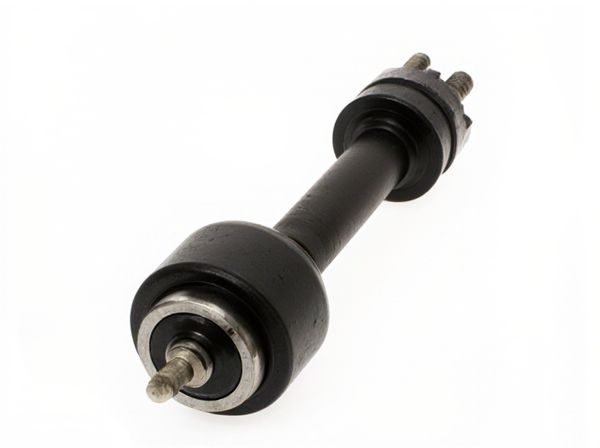
Photo illustration: Drop Axle vs Straight Axle
A drop axle features a design where the axle beam is bent downward between the wheels, lowering the vehicle's center of gravity for improved stability and handling. In contrast, a straight axle runs in a straight line across the vehicle's width, providing durability and simplicity, often preferred for heavy-duty applications. Your choice depends on whether you prioritize ride comfort and cornering performance (drop axle) or rugged strength and ease of maintenance (straight axle).
Table of Comparison
| Feature | Drop Axle | Straight Axle |
|---|---|---|
| Design | Axle beam drops below wheel hubs | Axle beam straight across at wheel hub level |
| Center of Gravity | Lower center of gravity for enhanced stability | Higher center of gravity |
| Load Capacity | Suitable for moderate loads | Better for heavy loads and commercial use |
| Ride Comfort | Improved comfort with better shock absorption | Less comfortable, stiffer ride |
| Ground Clearance | Reduced ground clearance | Higher ground clearance |
| Common Applications | Trailers, light-duty vehicles | Trucks, heavy-duty vehicles |
| Maintenance | Easier access to brakes and suspension | Standard maintenance complexity |
Introduction to Drop Axle and Straight Axle
Drop axles feature a design where the axle beam bends downward in the center, lowering the trailer or vehicle chassis for improved stability and easier loading. Straight axles maintain a uniform horizontal beam, offering simplicity and strength ideal for heavy-duty or off-road applications. Choosing between drop axles and straight axles depends on the vehicle's intended use, load requirements, and desired ground clearance.
What is a Drop Axle?
A drop axle is a type of vehicle axle designed with a downward bend in the central section, lowering the chassis and improving the center of gravity for enhanced stability and handling. Unlike a straight axle, which maintains a uniform height along its length, the drop axle allows for increased ground clearance near the wheels while keeping the vehicle body closer to the road. This design is commonly used in trailers and some trucks to reduce loading height and improve aerodynamic performance.
What is a Straight Axle?
A straight axle is a rigid, fixed shaft that connects both wheels on an axle, providing consistent alignment and strength for heavy loads. Commonly used in trailers, trucks, and off-road vehicles, straight axles offer durability and stability but do not lower the vehicle's deck height like drop axles do. This design ensures better load distribution and easier maintenance, making it ideal for applications requiring heavy-duty performance.
Key Differences Between Drop Axle and Straight Axle
Drop axles position the axle lower than the wheel hubs, resulting in a reduced trailer bed height and improved loading ease. Straight axles maintain a level alignment with the wheel hubs, offering increased ground clearance and simpler suspension setups. Drop axles enhance stability and aerodynamic efficiency, while straight axles provide better off-road capability and durability.
Advantages of Drop Axle
Drop axles provide improved ground clearance compared to straight axles, reducing the risk of damage when traversing uneven terrain. They enhance vehicle stability by lowering the suspension's mounting point, which helps maintain a lower center of gravity and improves handling. Drop axles also allow for greater tire clearance and larger wheel options, benefiting off-road and heavy-duty applications.
Advantages of Straight Axle
Straight axles offer superior durability and strength, making them ideal for heavy-duty applications and off-road conditions. Their design provides better wheel alignment and stability, resulting in improved handling and load distribution. This robust configuration also simplifies maintenance, reducing downtime and increasing overall vehicle reliability.
Common Applications: Drop Axle vs Straight Axle
Drop axles are commonly used in trailers and caravans for improved ground clearance, allowing better maneuverability on uneven terrain and reducing the risk of tire damage. Straight axles are typical in utility trailers, agricultural equipment, and heavy-duty trucks where maximum load-bearing capacity and durability are essential. Choosing between drop axle and straight axle depends on application requirements such as load type, ground clearance, and ride stability.
Performance Comparison: Ride, Handling, and Stability
Drop axles provide a lower ride height, which enhances stability by lowering the center of gravity and improving cornering performance. Straight axles offer increased ground clearance, beneficial for rough terrain but often result in a stiffer ride and less precise handling. Performance in ride comfort and handling varies significantly between the two, with drop axles favored for smooth, controlled driving and straight axles preferred for durability and off-road capability.
Maintenance and Durability Considerations
Drop axles typically require more frequent maintenance due to their complex design and additional moving parts, which can be prone to wear and corrosion, especially in harsh environments. Straight axles offer enhanced durability with fewer components, resulting in easier inspections and longer service life under heavy loads. Choosing between the two depends on balancing maintenance effort against durability needs for specific vehicle applications.
Choosing the Right Axle for Your Needs
Choosing the right axle depends on your trailer's specific requirements and intended use, with drop axles providing increased ground clearance and a lower deck height ideal for heavy loads and off-road conditions. Straight axles offer simplicity and strength, suited for trailers needing durability and ease of maintenance on flat terrains. Evaluating factors such as load capacity, terrain type, and clearance needs ensures optimal performance and safety for your trailer setup.
 caratoz.com
caratoz.com